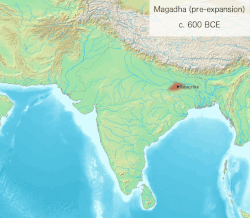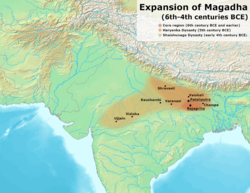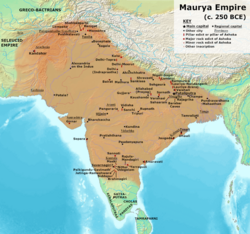
Back Magadha ALS مملكة ماجادها Arabic Magadha AST ماگدها AZB Магадха Bashkir Магадха Byelorussian Магадха Bulgarian मगध Bihari মগধ Bengali/Bangla མ་ག་དྷ་ Tibetan
Magadha | |||||||||||||
|---|---|---|---|---|---|---|---|---|---|---|---|---|---|
| 682 BCE – 28 BCE | |||||||||||||
 Kingdom of Magadha and other Mahajanapadas during the Second Urbanization. | |||||||||||||
Territorial expansion of the Magadha empire 6th century BCE onwards | |||||||||||||
| Capital | Rajagriha (Girivraj) Later, Pataliputra (modern-day Patna) | ||||||||||||
| Common languages | Sanskrit[1] Magadhi Prakrit Ardhamagadhi Prakrit | ||||||||||||
| Religion | Hinduism Buddhism Jainism | ||||||||||||
| Demonym(s) | Māgadhī | ||||||||||||
| Government | Absolute monarchy[a] | ||||||||||||
| Notable Emperors | |||||||||||||
• c. 544 – c. 492 BCE | Bimbisara | ||||||||||||
• c. 492 – c. 460 BCE | Ajatashatru | ||||||||||||
• c. 413 – c. 395 BCE | Shishunaga | ||||||||||||
• c. 395 – c. 367 BCE | Kalashoka | ||||||||||||
• c. 329 – c. 321 BCE | Dhana Nanda | ||||||||||||
• c. 321 – c. 297 BCE | Chandragupta Maurya | ||||||||||||
• c. 268 – c. 232 BCE | Ashoka | ||||||||||||
• c. 185 – c. 149 BCE | Pushyamitra Shunga | ||||||||||||
| Historical era | Iron Age | ||||||||||||
| Currency | Panas | ||||||||||||
| |||||||||||||
| Today part of | India | ||||||||||||
Magadha also called the Kingdom of Magadha or the Magadha Empire, was a kingdom and empire, and one of the sixteen Mahajanapadas, 'Great Kingdoms' of the Second Urbanization, based in southern Bihar in the eastern Ganges Plain, in Ancient India. Magadha was ruled by the Brihadratha dynasty (1700-682 BCE), the Pradyota dynasty (682-544 BCE), the Haryanka dynasty (544–413 BCE), the Shaishunaga dynasty (413–345 BCE), the Nanda dynasty (345–322 BCE), the Mauryan dynasty (322–184 BCE), the Shunga dynasty (184–73 BCE) and the Kanva dynasty (73–28 BCE). It lost much of its territory after being defeated by the Satavahanas of Deccan in 28 BC and was reduced to a small principality around Pataliputra.[2][3] Under the Mauryas, Magadha became a pan-Indian empire, covering large swaths of the Indian subcontinent and Afghanistan.
Magadha played an important role in the development of Jainism and Buddhism.[4] It was the core of four of northern India's greatest empires, the Nanda Empire (c. 345 – c. 322 BCE), Maurya Empire (c. 322–185 BCE), Shunga Empire (c. 185–78 BCE) and Gupta Empire (c. 319–550 CE). The Pala Empire also ruled over Magadha and maintained a royal camp in Pataliputra.[5][6]
The Pithipatis of Bodh Gaya referred to themselves as Magadhādipati and ruled in parts of Magadha until the 13th century.[7]
- ^ Jain, Dhanesh (2007). "Sociolinguistics of the Indo-Aryan languages". In George Cardona; Dhanesh Jain (eds.). The Indo-Aryan Languages. Routledge. pp. 47–66, 51. ISBN 978-1-135-79711-9.
- ^ Keny, Liladhar (1943). ""THE SUPPOSED IDENTIFICATION OF UDAYANA OF KAUŚĀMBI WITH UDAYIN OF MAGADHA"". Annals of the Bhandarkar Oriental Research Institute. 24 (1/2): 60–66. JSTOR 41784405.
- ^ Roy, Daya (1986). "SOME ASPECTS OF THE RELATION BETWEEN ANGA AND MAGADHA (600 B.C.—323 B.C.)". Proceedings of the Indian History Congress. 47: 108–112. JSTOR 44141530.
- ^ Damien Keown (26 August 2004). A Dictionary of Buddhism. OUP Oxford. p. 163. ISBN 978-0-19-157917-2.
- ^ Jhunu Bagchi (1993). The History and Culture of the Pālas of Bengal and Bihar, Cir. 750 A.D.-cir. 1200 A.D. Abhinav Publications. p. 64. ISBN 978-81-7017-301-4.
- ^ Jha, Tushar; Tyagi, Satish (2017). "CONTOURS OF THE POLITICAL LEGITIMATION STRATEGY OF THE RULERS OF PALA DYNASTY IN BENGAL- BIHAR (CE 730 TO CE 1165)". Proceedings of the Indian History Congress. 78: 49–58.
- ^ Balogh, Daniel (2021). Pithipati Puzzles: Custodians of the Diamond Throne. British Museum Research Publications. pp. 40–58. ISBN 9780861592289.
Cite error: There are <ref group=lower-alpha> tags or {{efn}} templates on this page, but the references will not show without a {{reflist|group=lower-alpha}} template or {{notelist}} template (see the help page).





